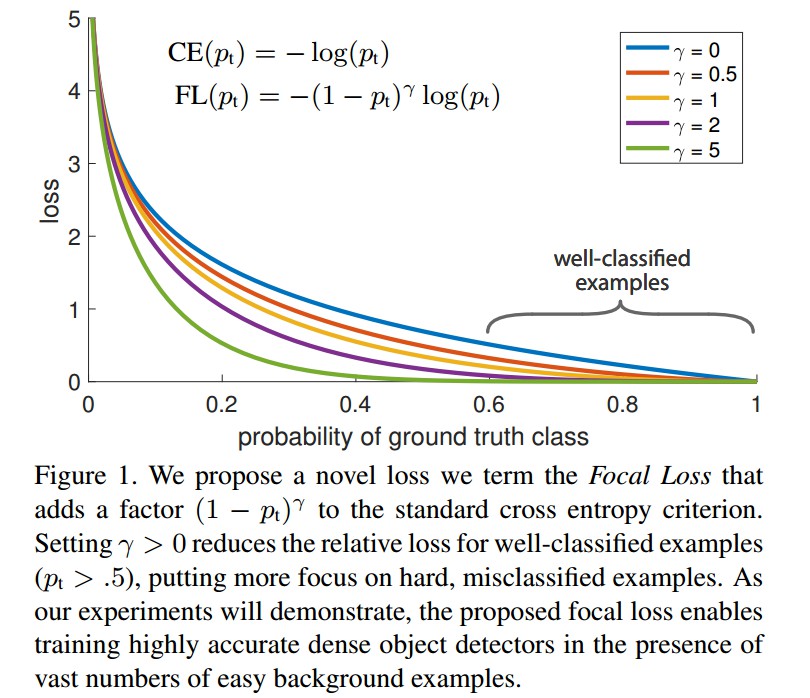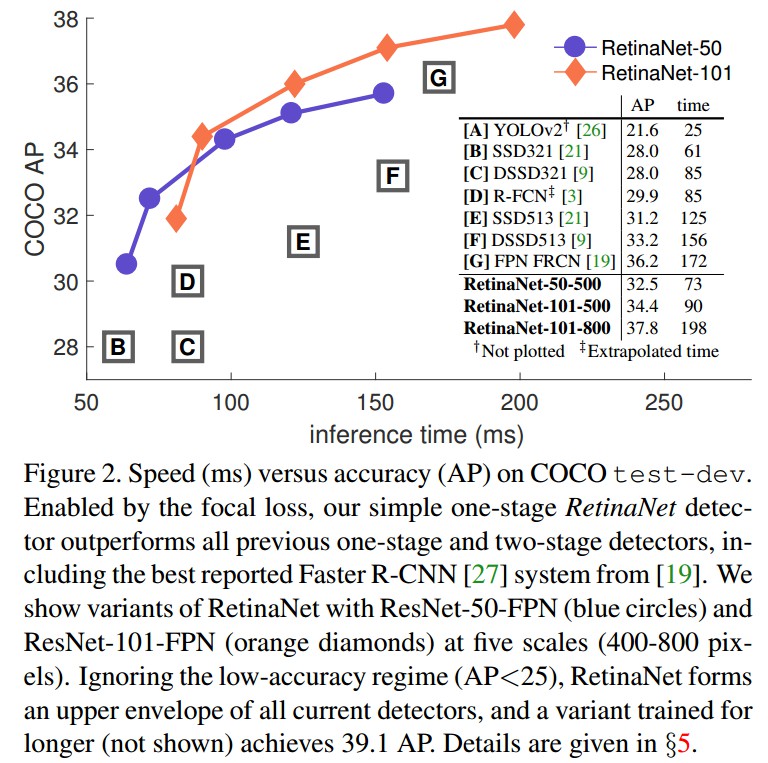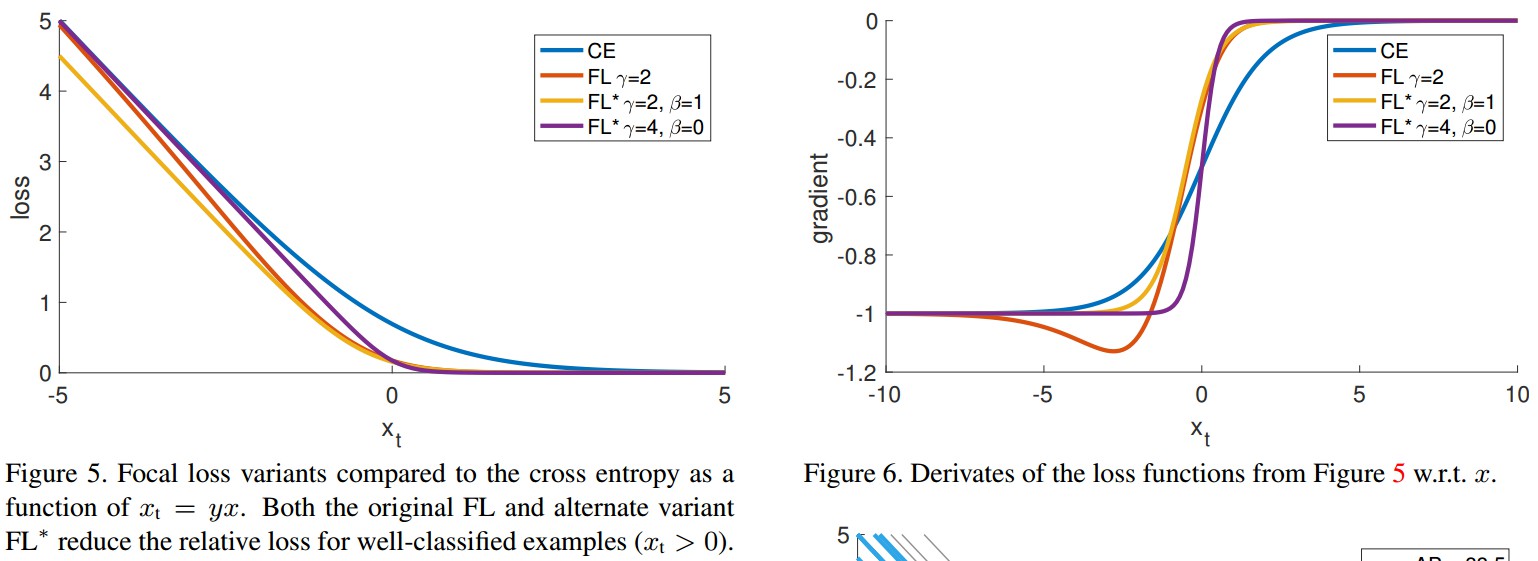题目: Focal Loss for Dense Object Detection - ICCV2017
作者: Tsung-Yi, Lin, Priya Goyal, Ross Girshick, Kaiming He, Piotr Dollar
团队: FAIR
精度最高的目标检测器往往基于 RCNN 的 two-stage 方法,对候选目标位置再采用分类器处理. 而,one-stage 目标检测器是对所有可能的目标位置进行规则的(regular)、密集采样,更快速简单,但是精度还在追赶 two-stage 检测器. <论文所关注的问题于此.>
论文发现,密集检测器训练过程中,所遇到的极端前景背景类别不均衡(extreme foreground-background class imbalance) 是核心原因.
对此,提出了 Focal Loss,通过修改标准的交叉熵损失函数,降低对能够很好分类样本的权重(down-weights the loss assigned to well-classified examples),解决类别不均衡问题.
Focal Loss 关注于在 hard samples 的稀疏子集进行训练,并避免在训练过程中大量的简单负样本淹没检测器. <RetinaNet>
Focal Loss 是动态缩放的交叉熵损失函数,随着对正确分类的置信增加,缩放因子(scaling factor) 衰退到 0. 如图:

Focal Loss 的缩放因子能够动态的调整训练过程中简单样本的权重,并让模型快速关注于困难样本(hard samples).
基于 Focal Loss 的 RetinaNet 的目标检测器表现.

1. Focal Loss
Focal Loss 旨在解决 one-stage 目标检测器在训练过程中出现的极端前景背景类不均衡的问题(如,前景:背景 = 1:1000).
首先基于二值分类的交叉熵(cross entropy, CE) 引入 Focal Loss:
$$ CE(p, y) = \begin{cases} -log(p) &\text{if } y=1 \\ -log(1-p) &\text{otherwise } \end{cases} $$
其中,$y \in \lbrace +1 -1 \rbrace$ 为 groundtruth 类别;$p \in [0, 1]$ 是模型对于类别 $y=1$ 所得到的预测概率.
符号简介起见,定义 $p_t$:
$$ p_t = \begin{cases} p &\text{if } y=1 \\ 1-p &\text{otherwise } \end{cases} $$
则,$CE(p, y) = CE(p_t) = -log(p_t)$.
CE Loss 如图 Figure 1 中的上面的蓝色曲线所示. 其一个显著特点是,对于简单易分的样本,如,$p_t \gg 0.5$,其 loss 也是一致对待. 当累加了大量简单样本的 loss 后,具有很小 loss 值的可能淹没稀少的类(rare class).
1.1 均衡交叉熵 Blanced CE
解决类别不均衡的一种常用方法是,对类别 +1 引入权重因子 $\alpha \in [0, 1]$,对于类别 -1 引入权重 $1 - \alpha$.
符号简介起见,定义 $\alpha _t$:
$$ \alpha_t = \begin{cases} \alpha &\text{if } y=1 \\ 1-\alpha &\text{otherwise } \end{cases} $$
则,$\alpha$-balanced CE loss 为:
$$ CE(p_t) = -\alpha _t log(p_t) $$
1.2 Focal Loss 定义
虽然 $\alpha$ 能够平衡 positive/negative 样本的重要性,但不能区分 easy/hard 样本.
对此,Focal Loss 提出将损失函数降低 easy 样本的权重,并关注于对 hard negatives 样本的训练.
添加调制因子(modulating factor) $(1 - p_t)^{\gamma}$ 到 CE loss,其中 $\gamma \ge 0$ 为可调的 focusing 参数.
Focal Loss 定义为:
$$ FL(p_t) = -(1 - p_t)^{\gamma} log(p_t) $$
如图 Figure 1,给出了 $\gamma \in [0, 5]$ 中几个值的可视化.
Focal Loss 的两个属性:
[1] - 当样本被误分,且 $p_t$ 值很小时,调制因子接近于 1,loss 不受影响. 随着 $p_t \rightarrow 1$,则调制因子接近于 0,则容易分类的样本的损失函数被降低权重.
[2] - focusing 参数 $\gamma$ 平滑地调整哪些 easy 样本会被降低权重的比率(rate). 当 $\gamma=0$,FL=CE;随着 $\gamma $ 增加,调制因子的影响也会随之增加(实验中发现 $\gamma = 2$ 效果最佳.)
直观上,调制因子能够减少 easy 样本对于损失函数的贡献,并延伸了loss 值比较地的样本范围.
例如,$\gamma = 0.2$ 时,被分类为 $p_t=0.9$ 的样本,与 CE 相比,会减少 100x 倍;而且,被分类为 $p_t \approx 0.968 $ 的样本,与 CE 相比,会有少于 1000x 倍的 loss 值. 这就自然增加了将难分类样本的重要性(如 $\gamma= 2$ 且 $p_t \leq 0.5$ 时,难分类样本的 loss 值会增加 4x 倍.)
实际上,论文采用了 Focal Loss 的 $\alpha$ -balanced 变形:
$$ FL(p_t) = -\alpha _t (1 - p_t)^{\gamma} log(p_t) $$
1.3. Focal Loss 例示
Focal Loss 并不局限于具体的形式. 这里给出另一种例示.
假设 $p = \sigma(x) = \frac{1}{1 + e^{-x}}$,
定义 $p_t$为(类似于前面对于 $p_t$ 的定义):
$$ p_t = \begin{cases} p &\text{if } y=1 \\ 1-p &\text{otherwise } \end{cases} $$
定义:$x_t = yx$,其中,$y \in \lbrace +1, -1 \rbrace$ 是 groundtruth 类别.
则:
$$ p_t = \sigma(x_t) = \frac{1}{1 + e^{-yx}} $$
当 $x_t > 0$ 时,样本被正确分类,此时 $p_t > 0.5$.
有:
$$ \frac{d p_t}{d x} = \frac{-1}{(1 + e^{-yx})^2} * (-y) * e^{-yx} = y * p_t * (1 - p_t) = -y * p_t * (p_t - 1) $$
对于交叉熵损失函数 $CE(p_t) = -log(p_t)$,由$\frac{d lnx}{d x} = \frac{1}{x}$,
$$ \frac{d CE(p_t)}{d x} = \frac{d CE(p_t)}{d p_t} * \frac{d p_t}{d x} = (- \frac{1}{p_t}) * (-y*p_t*(p_t - 1)) = y*(p_t - 1) $$
对于 Focal Loss $FL(p_t) = -(1 - p_t)^{\gamma} log(p_t)$,其中 $\gamma$ 为常数.
$$ \frac{d FL(p_t)}{d x} = \frac{d (1-p_t)^{\gamma}}{d x} * (-log(p_t)) + (1-p_t)^{\gamma}*\frac{d CE(p_t)}{d x} $$
$$ \frac{d FL(p_t)}{d x} = (\gamma * (1-p_t)^{\gamma-1}*\frac{d (1-p_t)}{d p_t})*\frac{d p_t}{d x} * (-log(p_t)) + (1-p_t)^{\gamma}*y*(p_t -1) $$
$$ \frac{d FL(p_t)}{d x} = (\gamma *(1- p_t)^{\gamma -1} * (-1))*(-y * p_t*(p_t -1))*(-log(p_t)) + y*(1-p_t)^{\gamma}*(p_t -1) $$
$$ \frac{d FL(p_t)}{d x} = \gamma *(1-p_t)^{\gamma}*y*p_t*log(p_t) + y*(1-p_t)^{\gamma}*(p_t - 1) $$
$$ \frac{d FL(p_t)}{d x} = y*(1-p_t)^{\gamma}*(\gamma * p_t *log(p_t) + (p_t - 1)) $$
再者,假设 $p_t^* = \sigma (\gamma x_t + \beta)$,则 $FL^*(p_t^{*}) = -log(p_t^*)/ \gamma$,其中 $\gamma$ 为常数.
$$ \frac{d FL^*(p_t^*)}{d x} = -\frac{1}{p_t^*}*\frac{1}{\gamma}*\frac{d p_t^*}{d (\gamma x_t + \beta)} * \frac{d( \gamma x_t + \beta)}{d x} $$
$$ \frac{d FL^*(p_t^*)}{d x} = -\frac{1}{p_t^*} * \frac{1}{\gamma} * (-y * p_t^* * (p_t^* - 1)*\gamma) = y*(p_t^* - 1) $$
则,$FL^*$ 包含两个参数 $\gamma$ 和 $\beta$,控制着 loss 曲线的陡度(steepness) 和移动(shift). 如 Figure 5.

1.4. Focal Loss 求导
$CE$ 关于 $x$ 的求导:
$$ \frac{d CE}{ dx} = y(p_t - 1) $$
$FL$ 关于 $x$ 的求导:
$$ \frac{d FL}{d x} = y(1-p_t)^{\gamma} (\gamma p_t log(p_t) + p_t - 1) $$
$FL^*$ 关于 $x$ 的求导:
$$ \frac{d FL^*}{d x} = y(p_t^* - 1) $$
如图 Figure 6. 三种 loss 函数,对于high-confidence 的预测结果,其导数都趋近于 -1 或 0.
但,与 $CE$ 不同的是,$FL$ 和 $FL^*$ 的有效设置时,只要 $x_t > 0$,二者的导数都是很小的.
2. SoftmaxFocalLoss 求导
Focal Loss 损失函数:
$$ FL(p_t) = - \alpha (1 - p_t)^{\gamma} log(p_t) $$
其中:
$$ p_t = \begin{cases} p &\text{if } y=1 \\ 1-p &\text{otherwise } \end{cases} $$
Softmax 函数:
$$ p_i = \frac{e^{x_i}}{\sum _{k=1}^K e^{x_k}} $$
其中,$K$ 为类别数,$x$ 是网络全连接层等的输出向量,$x_i$ 是向量的第 $i$ 个元素值.
则 $FL$ 关于 $x$ 求导:
$$ \frac{d FL}{d x_i} = \frac{d FL}{d p_i} * \frac{d p_i}{d x_i} $$
而,
$$ \frac{d FL}{d p_t} = - \alpha (\frac{d (1-p_t)^{\gamma}}{d p_t} * log(p_t) + (1-p_t)^{\gamma} * \frac{d (log(p_t))}{d p_t}) $$
$$ \frac{d FL}{d p_t} = - \alpha (- \gamma * (1-p_t)^{\gamma - 1} * log(p_t) + (1-p_t)^{\gamma} * \frac{1}{p_t}) $$
Softmax 函数关于 x 的求导为:
$$ \frac{d p_i}{d x_i} = \frac{d \frac{e^{x_i}}{\sum _{k=1}^K e^{x_k}}}{d x_i} $$
$$ \frac{d p_i}{d x_i} = \frac{\frac{d(e^{x_i})}{d x_i}*\sum _{k=1}^K e^{x_k} - e^{x_i}*\frac{d(\sum _{k=1}^K e^{x_k})}{dx_i}}{(\sum _{k=1}^K e^{x_k})^2} $$
当 $i=j$ 时,
$$ \frac{d p_i}{d x_i} = \frac{e^{x_i}*\sum _{k=1}^K e^{x_k} - e^{x_i}*e^{x_i}}{(\sum _{k=1}^K e^{x_k})^2} $$
$$ \frac{d p_i}{d x_i} = \frac{e^{x_i}}{\sum _{k=1}^K e^{x_k}} - \frac{e^{x_i}}{\sum _{k=1}^K e^{x_k}}* \frac{e^{x_i}}{\sum _{k=1}^K e^{x_k}} $$
$$ \frac{d p_i}{d x_i} = p_i - p_i * p_i = p_i(1 - p_i) $$
当 $i \neq j$ 时,
$$ \frac{d p_i}{d x_i} = \frac{0 - e^{x_i}*e^{x_j}}{(\sum _{k=1}^K e^{x_k})^2} $$
$$ \frac{d p_i}{d x_i} = - \frac{e^{x_i}}{\sum _{k=1}^K e^{x_k}}* \frac{e^{x_j}}{\sum _{k=1}^K e^{x_k}} $$
$$ \frac{d p_i}{d x_i} = -p_i * p_j $$
Softmax 的函数求导即为:
$$ \frac{d p_i}{d x_i} = \begin{cases} p_i(1-p_i) &\text{if } i=j \\ -p_i*p_j &\text{if } i \neq j \end{cases} $$
故:
$$ \frac{d FL}{d x_i} = \begin{cases} - \alpha (- \gamma * (1-p_i)^{\gamma - 1} * log(p_i) + (1-p_i)^{\gamma} * \frac{1}{p_i}) * p_i(1-p_i) &\text{if } i=j \\ - \alpha (- \gamma * (1-p_i)^{\gamma - 1} * log(p_i) + (1-p_i)^{\gamma} * \frac{1}{p_i}) * (-p_i*p_j) &\text{if } i \neq j \end{cases} $$
$$ \frac{d FL}{d x_i} = \begin{cases} \alpha (- \gamma * (1-p_i)^{\gamma - 1} * log(p_i)p_i + (1-p_i)^{\gamma}) * (p_i-1) &\text{if } i=j \\ \alpha (- \gamma * (1-p_i)^{\gamma - 1} * log(p_i)p_i + (1-p_i)^{\gamma}) * p_j &\text{if } i \neq j \end{cases} $$
3. Pytorch 实现
import torch
import torch.nn as nn
import torch.nn.functional as F
class FocalLoss(nn.Module):
def __init__(self, alpha=0.25, gamma=2, size_average=True):
super(FocalLoss, self).__init__()
self.alpha = alpha
self.gamma = torch.Tensor([gamma])
self.size_average = size_average
if isinstance(alpha, (float, int, long)):
if self.alpha > 1:
raise ValueError('Not supported value, alpha should be small than 1.0')
else:
self.alpha = torch.Tensor([alpha, 1.0 - alpha])
if isinstance(alpha, list): self.alpha = torch.Tensor(alpha)
self.alpha /= torch.sum(self.alpha)
def forward(self, input, target):
if input.dim() > 2:
input = input.view(input.size(0), input.size(1), -1) # [N,C,H,W]->[N,C,H*W] ([N,C,D,H,W]->[N,C,D*H*W])
# target
# [N,1,D,H,W] ->[N*D*H*W,1]
if self.alpha.device != input.device:
self.alpha = torch.tensor(self.alpha, device=input.device)
target = target.view(-1, 1)
logpt = torch.log(input + 1e-10)
logpt = logpt.gather(1, target)
logpt = logpt.view(-1, 1)
pt = torch.exp(logpt)
alpha = self.alpha.gather(0, target.view(-1))
gamma = self.gamma
if not self.gamma.device == input.device:
gamma = torch.tensor(self.gamma, device=input.device)
loss = -1 * alpha * torch.pow((1 - pt), gamma) * logpt
if self.size_average:
loss = loss.mean()
else:
loss = loss.sum()
return loss4. Keras 实现
基于 Keras 和 TensorFlow 后端实现的 Binary Focal Loss 和 Categorical/Multiclass Focal Loss.
主要设计两个参数:alpha 和 gamma.
用法:
model.compile(optimizer='adam', loss=categorical_focal_loss(gamma=2.0, alpha=0.25), metrics=['accuracy'])实现:
#!/usr/bin/env python3
# -*- coding: utf-8 -*-
"""
Created on Fri Oct 19 08:20:58 2018
@OS: Ubuntu 18.04
@IDE: Spyder3
@author: Aldi Faizal Dimara (Steam ID: phenomos)
"""
import keras.backend as K
import tensorflow as tf
def categorical_focal_loss(gamma=2.0, alpha=0.25):
"""
Implementation of Focal Loss from the paper in multiclass classification
Formula:
loss = -alpha*((1-p)^gamma)*log(p)
Parameters:
alpha -- the same as wighting factor in balanced cross entropy
gamma -- focusing parameter for modulating factor (1-p)
Default value:
gamma -- 2.0 as mentioned in the paper
alpha -- 0.25 as mentioned in the paper
"""
def focal_loss(y_true, y_pred):
# Define epsilon so that the backpropagation will not result in NaN
# for 0 divisor case
epsilon = K.epsilon()
# Add the epsilon to prediction value
#y_pred = y_pred + epsilon
# Clip the prediction value
y_pred = K.clip(y_pred, epsilon, 1.0-epsilon)
# Calculate cross entropy
cross_entropy = -y_true*K.log(y_pred)
# Calculate weight that consists of modulating factor and weighting factor
weight = alpha * y_true * K.pow((1-y_pred), gamma)
# Calculate focal loss
loss = weight * cross_entropy
# Sum the losses in mini_batch
loss = K.sum(loss, axis=1)
return loss
return focal_loss
def binary_focal_loss(gamma=2.0, alpha=0.25):
"""
Implementation of Focal Loss from the paper in multiclass classification
Formula:
loss = -alpha_t*((1-p_t)^gamma)*log(p_t)
p_t = y_pred, if y_true = 1
p_t = 1-y_pred, otherwise
alpha_t = alpha, if y_true=1
alpha_t = 1-alpha, otherwise
cross_entropy = -log(p_t)
Parameters:
alpha -- the same as wighting factor in balanced cross entropy
gamma -- focusing parameter for modulating factor (1-p)
Default value:
gamma -- 2.0 as mentioned in the paper
alpha -- 0.25 as mentioned in the paper
"""
def focal_loss(y_true, y_pred):
# Define epsilon so that the backpropagation will not result in NaN
# for 0 divisor case
epsilon = K.epsilon()
# Add the epsilon to prediction value
#y_pred = y_pred + epsilon
# Clip the prediciton value
y_pred = K.clip(y_pred, epsilon, 1.0-epsilon)
# Calculate p_t
p_t = tf.where(K.equal(y_true, 1), y_pred, 1-y_pred)
# Calculate alpha_t
alpha_factor = K.ones_like(y_true)*alpha
alpha_t = tf.where(K.equal(y_true, 1), alpha_factor, 1-alpha_factor)
# Calculate cross entropy
cross_entropy = -K.log(p_t)
weight = alpha_t * K.pow((1-p_t), gamma)
# Calculate focal loss
loss = weight * cross_entropy
# Sum the losses in mini_batch
loss = K.sum(loss, axis=1)
return loss
return focal_loss Related
[1] - Focal Loss 的前向与后向公式推导
2 comments
对FL关于x求导之后的结果有什么含义吗?能证实focal loss什么?
主要是想说明 Focal loss 的参数对损失函数的影响吧